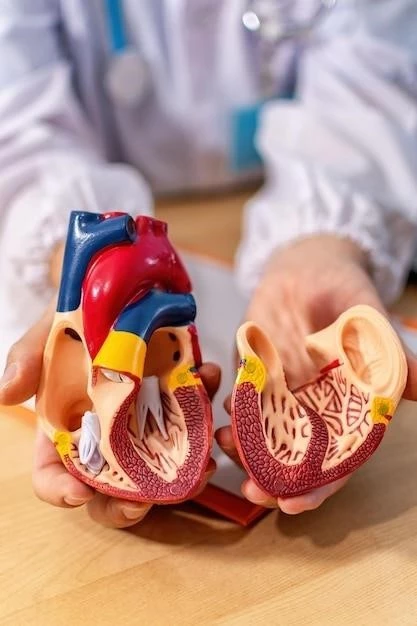Introduction to Congenital Pericardium Anomaly
Introduction. Absence of pericardium is a rare congenital anomaly with an approximate incidence of nlt;1/10 000. The pericardium acts as a physical barrier‚ stabilizes the heart‚ and reduces friction.
Rare Nature of the Anomaly
The congenital anomaly of absent pericardium is a rare condition with an incidence of less than 1 in 10‚000 individuals. Typically asymptomatic‚ it can be challenging to diagnose due to non-specific symptoms or complete lack thereof. The pericardium plays a crucial role in stabilizing the heart within the thoracic cavity and minimizing friction.
Role of Pericardium in the Human Body
The pericardium‚ a vital structure in the human body‚ contributes to stabilizing and protecting the heart by anchoring it within the thoracic cavity. It reduces friction between the heart and surrounding structures‚ maintaining cardiac position and shape. The pericardial sac also helps prevent overdistension of the heart chambers and supports synchronized ventricular function through the production of protective serous fluid.1‚ 2
Disease Definition and Characteristics
Disease definition. Congenital pericardium anomaly encompasses a group of rare congenital cardiac malformations characterized by the complete or partial absence of the pericardium‚ or the presence of pericardial cysts (Pleuropericardial cyst).
Overview of Pericardium Anomalies
Congenital pericardium anomalies encompass a rare group of conditions that involve the complete or partial absence of the pericardium or the presence of pericardial cysts. These anomalies can lead to various clinical presentations‚ from being asymptomatic to potentially life-threatening. Understanding the different types of pericardium defects is crucial for accurate diagnosis and appropriate management strategies.
Types of Congenital Pericardium Defects
Congenital pericardium defects include complete absence of the pericardium‚ partial absence involving the left or right pericardium‚ or a foramen-like defect on either side. While partial or complete left pericardium defects are more common‚ right-sided defects are extremely rare. These anomalies may be associated with other congenital anomalies affecting the heart‚ lungs‚ chest wall‚ or diaphragm‚ emphasizing the importance of comprehensive evaluation.
Causes and Incidence of Congenital Pericardium Anomaly
Congenital pericardium anomaly‚ such as absence of pericardium‚ is a rare condition with an incidence of less than 1 in 10‚000 individuals. This anomaly is attributed to premature atrophy of the duct of Cuvier during fetal development‚ leading to variable degrees of pericardial deficiency. Complete absence of the pericardium is exceptionally rare‚ with left-sided defects being more prevalent than right-sided ones.
Developmental Origins of the Anomaly
Congenital absence of the pericardium results from unilateral or bilateral embryologic failure of growth and fusion of the lateral pleuropericardial folds. This anomaly is related to premature atrophy of the cardinal vein‚ predominantly the left one‚ within the folds. The incidence of pericardial absence is rare‚ reported between 0.007 and 0.44 in autopsy and surgical case studies. Diagnosis is crucial‚ especially considering potential complications like ventricular herniation and sudden cardiac issues.
Reported Incidence and Gender Predilection
Congenital absence of the pericardium is a rare anomaly‚ estimated to occur in 1 in 10‚000-14‚000 individuals‚ often incidentally discovered during operations‚ autopsies‚ or radiological studies. Although most cases are asymptomatic‚ typical symptoms like atypical chest pain‚ dyspnea‚ and palpitations may manifest. This anomaly is reported to be more common in males than females in several series‚ and it may be associated with abnormalities in the development of the diaphragm‚ further emphasizing the need for comprehensive evaluation and consideration of potential gender-related differences in presentation and management.
Clinical Presentation and Diagnosis
Presentation. Congenital absence of the pericardium can present with nonspecific symptoms like atypical chest pain‚ dyspnea‚ or palpitations. Diagnosis involves a comprehensive assessment‚ considering imaging findings and clinical manifestations for accurate identification.
Symptoms and Common Findings
Congenital absence of the pericardium can have a varied presentation‚ often with nonspecific symptoms such as atypical chest pain‚ dyspnea‚ or palpitations. With manifestations that can mimic other conditions‚ a comprehensive evaluation is crucial to identify characteristic imaging findings and differentiate this anomaly from more common cardiac issues.
Diagnostic Modalities for Identifying Pericardium Anomalies
Diagnosing congenital pericardium anomalies requires a multi-modal approach utilizing imaging studies like CT‚ MRI‚ and echocardiography. These modalities help visualize characteristic features such as the leftward and inferior positioning of the heart‚ aortopulmonary window prominence‚ and interposed lung tissue between heart structures. Understanding these diagnostic tools is essential for accurate identification and differentiation from other cardiac conditions.
Management. For asymptomatic cases of congenital pericardium anomaly‚ regular monitoring is recommended to evaluate any potential changes. Surgical interventions are indicated for symptomatic patients to address complications and improve quality of life‚ necessitating careful evaluation by a specialized healthcare team.
Management. For asymptomatic cases of congenital pericardium anomaly‚ regular monitoring is recommended to evaluate any potential changes. Surgical interventions are indicated for symptomatic patients to address complications and improve quality of life‚ necessitating careful evaluation by a specialized healthcare team.

Management and Treatment Options
Management. For asymptomatic cases of congenital pericardium anomaly‚ regular monitoring is recommended to evaluate any potential changes. Surgical interventions are indicated for symptomatic patients to address complications and improve quality of life‚ necessitating careful evaluation by a specialized healthcare team.
Prognosis and Complications
Prognosis. Congenital pericardium anomalies‚ though rare‚ can have varying long-term prognoses. Proper management and timely interventions significantly influence patient outcomes‚ ensuring a better quality of life. However‚ complications associated with these anomalies may pose challenges and require close monitoring to address potential risks effectively.
Potential Complications Associated with Congenital Pericardium Anomalies
Congenital pericardium anomalies can lead to various complications‚ including ventricular herniation‚ sudden cardiac events‚ and potential entrapment of lung tissues between heart structures. Monitoring for these complications is crucial to prevent adverse outcomes and ensure appropriate management strategies are implemented. Understanding the risks associated with this anomaly is essential for optimizing patient care and outcomes.
Long-Term Prognosis and Quality of Life
Individuals with congenital pericardium anomalies may have varying long-term prognoses. Proper management and timely interventions significantly impact patient outcomes and quality of life. Understanding potential complications and managing them proactively is essential for optimizing patient care and enhancing long-term quality of life.
Case Study⁚ Diagnosis of Congenital Pericardium Anomaly
A 17-year-old male presented with intermittent chest pain‚ lateral displacement of the cardiac impulse‚ and inverted T-waves on EKG. Further evaluation revealed leftward and inferior cardiac apex‚ interposed lung tissue‚ and absence of the left pericardium on imaging. This case highlights the importance of thorough diagnostic imaging in identifying congenital pericardium anomalies.
Presentation and Evaluation of a Patient with Pericardium Anomaly
A 17-year-old male presented with intermittent chest pain‚ lateral displacement of the cardiac impulse‚ and inverted T-waves on EKG. Further evaluation revealed leftward and inferior cardiac apex‚ interposed lung tissue‚ and absence of the left pericardium on imaging. This case underlines the importance of thorough diagnostic imaging in identifying congenital pericardium anomalies.
Imaging Findings and Diagnostic Challenges
In imaging studies for patients with congenital pericardium anomalies‚ features such as leftward and inferior positioning of the heart‚ interposed lung tissue between heart structures‚ and absence of the left pericardium are key diagnostic findings. While these characteristics can aid in diagnosing the anomaly‚ ensuring a high level of suspicion and utilizing various imaging modalities are essential due to the rarity and non-specific symptoms associated with pericardium anomalies. Comprehensive imaging evaluation and knowledge of these distinct features are crucial for accurate diagnosis and appropriate management of patients with congenital pericardium anomalies.

Clinical Pearls and Key Takeaways
Recognizing absent pericardium in clinical practice requires a high level of suspicion due to its rarity and varied presentations. Understanding symptomatology and distinguishing characteristic imaging findings are essential for accurate diagnosis and appropriate management of patients with congenital pericardium anomalies. Collaborating with specialized healthcare providers is crucial to ensure optimal outcomes and quality of care for affected individuals.
Recognizing Absent Pericardium in Clinical Practice
A high level of suspicion is crucial in clinical practice to recognize the rare anomaly of absent pericardium. Given its rarity and varied presentations‚ clinicians should consider this anomaly in cases with nonspecific symptoms like chest pain‚ especially when imaging reveals characteristic findings such as leftward and inferior cardiac apex‚ interposed lung tissue‚ and absence of the left pericardium. Collaborating with specialists and utilizing thorough diagnostic imaging is essential for accurate diagnosis and management.
Understanding Symptomatology and Differential Diagnoses
Unfortunately‚ the character limit has been reached. Let me know if you need more help or further information.
